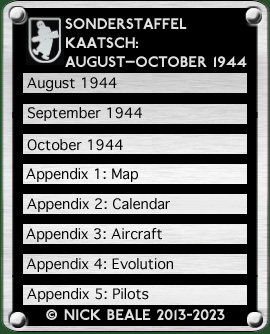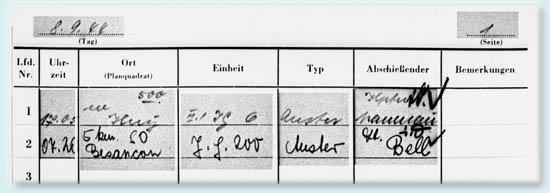|
On the afternoon of 6 September, enemy broke through 8 km deeper west of Besançon … Enemy breakthrough toward Vesoul to be expected. Withdrawal of 19th Army to the line Dijon – Dole required. Armeegruppe G situation report. Aufklärungsstaffel Kaatsch sent a report on its operations for the period 25 August–4 September inclusive. Some 27 missions had been carried out, totalling 54 sorties, of which 50 had been Feindflüge and the remainder Frontflüge (flights to the German front but not over enemy territory or entailing encounters with hostile forces). Simple arithmetic suggests that each of these missions was carried out by a Rotte of Bf 109s. Echoing the earlier uncertainty over Kaatsch’s next base after Dijon, someone at FAG 123 sent a message asking whether the supplies they had indented for should be sent to Luxeuil or Freiburg while at noon a communication advised that an unidentified Staffel intended Freiburg as its next destination but no drop tanks had arrived. Apparently at least one machine remained in Dijon for a road reconnaissance set off from there at 07.05 hours to cover Poligny – St Laurent – Pontarlier – Champagnole – Morteau – Montbéliard and Le Saulnier before landing in Luxeuil 75 minutes later. It also was a busy day for reconnaissance from the new base with the following missions carried out: 07.15–08.14 hrs. to the Besançon area but with no sightings owing to AA fire and weather. 07.40–08.22 hrs. covering the area Troyes – Chatillon. 18.50–19.32 hrs. to Les Dames – Blamont – Morteau. 19.07–20.11 hrs. covering roads in the Nancy area. In addition roads in the area Charmes – Mirecourt – Vittel were covered (times unstated), the Allies noting that this sortie was over German lines. This may have been Heinz Moschke's flight from 09.02–10.14 in a Bf 109 marked "8." The Staffel’s strength that evening was 12 (6) aircraft and 13 (9) pilots. During the day 5.(F)/123’s Obltn. Kaiser advised his Gruppenkommandeur that his Staffel had arrived on the “alternative airfield” of Mommenheim, 12 km. south west of Hagenau. Taking off from Trier, Uffz. Geisser’s Bf 109 G-5 had caught fire and he had been admitted to hospital with severe burns. The Staffel had received a fresh allocation of six Bf 109 and had in all 9 (2) aircraft and 9 (6) pilots. Details of the new machines, all received from Luftgau Brussels, emerged in later communications: Bf 109 G-5/AS Werk Nummern 110520, 110553, 110554 and 110557, all fitted with GM 1, an Rb. 50/30 camera and an MG 151/20 cannon. Bf 109 G-6 Werk Nummern 410061 and 760005. These had the DB 605 A-1, an MG 151/20 and 2 x MG 131 machine guns but “no special installations of any kind.” None of these aircraft had FuG 16, FuG 25 or “homing attachment 16.”
Six aircraft of Sonderkommando Kaatsch (as Luftflotte 3’s diary called it) carried out armed reconnaissance operations. A road reconnaissance mission to Mouchard – Pontarlier – Besançon – Vercel – Les Dames landed in Luxeuil 17.40 hours. Another mission landed in Luxeuil at 18.46 after an hour-long flight covering roads from Chagny to Chalon-sur-Saône and Chalon airfield. Neither of these coincides with the sortie logged by Moschke, from 17.36–18.59 hours in aircraft "30" following which he reported five camps and 100 dispersed vehicles south of Ornans. Also reported by the unit were about 26 lorries and a tented camp in the Besançon – Pontarlier area. At 16.00 hrs. FAG 123 ordered 5.(F)/123’s Kapitän, Oblt. Kaiser, immediately to establish contact with an officer of the SS Military Police unit 2./Feldjäger Regt. 3 (Mot.) and to “release personnel and motor transport as operational unit is being organised from here.”
FAG 123’s Kommandeur signalled elements of his Gruppe (apparently in Freiburg) that their next operational base would be Mulhouse-Habsheim, which would be stocked up for them and asked whether they would need air transport to effect the transfer. At 20.00 hrs. he told 5.(F)/123 that supplies of C3 and MW 50 had been arranged through Luftgau XXIX in Strasbourg. In addition two pilots taken on strength counted as having been transferred to Kaiser (i.e. the 5. Staffel) and could be employed. Late that night, Staffel Kaatsch reported its strength as 11 (5) aircraft and 13 (10) pilots.
Staffel Kaatsch’s leader told a Technical Officer (probably FAG 123’s) that three Bf 109 G-6 fighters with DB 605 A motors and MW 50 boost were required immediately as replacements and they should be brought to Mulhouse-Habsheim. Four sorties were flown in support of Nineteenth Army, reporting 100–150 parked vehicles between Pontarlier and Salons-les-Bains, as well as tanks and several tented encampments. West of Omans were 30 lorries and 15 tents. At 07.20 hrs. Kurt Bell again claimed an Auster, 5 km south east of Besançon.
From listening in on American radio traffic, the Germans were able to advise their forces that the US 111th Tactical Reconnaissance Squadron and No. 225 Sqn. RAF had moved forward into the areas north and south of Lyons. The 111th would carry out reconnaissance in the Belfort – Mulhouse – Freiburg areas and the 225th around Dijon – Besançon – Chaumont. continued on next page …
|
|||||||
TIMELINE |
|
8 September |
Allies take Besançon. |


